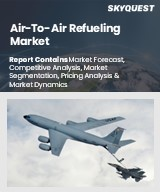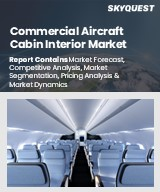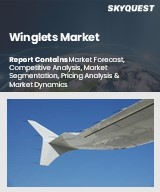
|
시장보고서
상품코드
1691670
세계의 항공기 부품 시장 평가 : 항공기 유형별, 부품별, 지역별, 기회, 예측(2018-2032년)Aircraft Component Market Assessment, By Aircraft Type, By Components, By Region, Opportunities and Forecast, 2018-2032F |
||||||
세계 항공기 부품 시장 규모는 2024년 3,302억 9,000만 달러에서 2032년에는 5,890억 5,000만 달러에 달할 것으로 예상되며, 2025-2032년의 예측 기간 동안 연평균 7.50% 성장할 것으로 예상됩니다. 시장은 최근 몇 년동안 괄목할 만한 성장을 보였으며, 앞으로도 강력한 확장 속도를 유지할 것으로 예상됩니다. 세계 항공기 부품 시장은 개발도상국의 항공 여행 증가, 항공기 인도량 증가 및 항공기 보유량 증가로 인해 성장세를 보이고 있습니다. 또한, 재료의 구성과 지속가능성에 대한 기술 발전도 이 시장의 성장을 뒷받침하고 있습니다.
세계 항공기 부품 시장은 항공 산업의 기술 발전, 경량 복합재료의 사용 증가, 설계의 발전, IoT 및 AI와 같은 새로운 혁신 기술의 통합, 효과적인 유지보수를 위한 진단 및 예측 능력의 변화 등 여러 요인으로 인해 괄목할 만한 성장세를 보이고 있습니다.
예를 들어, 2025년 2월 Azad Engineering Limited는 Rolls-Royce Holdings plc와 민간 항공기 엔진용 핵심 부품 제조 및 공급에 대한 장기 계약을 체결했습니다. 이 파트너십을 통해 엔진 프로그램의 전체 수명주기 동안 매우 복잡한 가공 부품을 인도에서 생산하게 됩니다. 이번 계약은 항공우주 제조 분야에서 혁신과 정밀도를 중시하는 양사의 협력 관계를 강화하는 계기가 될 것입니다.
세계의 항공기 부품 시장에 대해 조사 분석했으며, 시장 규모와 예측, 시장 역학, 주요 기업 개요 등의 정보를 전해드립니다.
목차
제1장 프로젝트의 범위와 정의
제2장 조사 방법
제3장 주요 요약
제4장 고객의 소리
- 제품과 시장 정보
- 브랜드 인지도
- 구입 결정에서 고려되는 요소
- 리드타임
- 애프터 지원
제5장 세계의 항공기 부품 시장 전망(2018년-2032년)
- 시장 규모 분석과 예측
- 금액
- 시장 점유율 분석과 예측
- 용도별
- 컴포넌트별
- 지역별
- 시장 점유율 분석 : 기업별(금액)(주요 5개사와 기타 - 2024년)
- 시장 맵 분석(2024년)
- 용도별
- 컴포넌트별
- 지역별
제6장 북미의 항공기 부품 시장 전망(2018년-2032년)
- 시장 규모 분석과 예측
- 금액
- 시장 점유율 분석과 예측
- 용도별
- 컴포넌트별
- 점유율 : 국가별
- 국가별 시장 평가
- 미국의 항공기 부품 시장 전망(2018년-2032년)
- 캐나다
- 멕시코
제7장 유럽의 항공기 부품 시장 전망(2018년-2032년)
- 독일
- 프랑스
- 이탈리아
- 영국
- 러시아
- 네덜란드
- 스페인
- 터키
- 폴란드
제8장 아시아태평양의 항공기 부품 시장 전망(2018년-2032년)
- 인도
- 중국
- 일본
- 호주
- 베트남
- 한국
- 인도네시아
- 필리핀
제9장 남미의 항공기 부품 시장 전망(2018년-2032년)
- 브라질
- 아르헨티나
제10장 중동 및 아프리카의 항공기 부품 시장 전망(2018년-2032년)
- 사우디아라비아
- 아랍에미리트(UAE)
- 남아프리카공화국
제11장 Porter의 Five Forces 분석
제12장 PESTLE 분석
제13장 시장 역학
- 시장 성장 촉진요인
- 시장이 해결해야 할 과제
제14장 시장 동향과 발전
제15장 사례 연구
제16장 경쟁 구도
- 시장 리더 주요 5개사의 경쟁 매트릭스
- 주요 5개사의 SWOT 분석
- 주요 기업 상위 8사 상황
- The Boeing Company
- Airbus SE
- RTX Corporation
- Bombardier Inc.
- General Electric Company
- Honeywell International Inc.
- Rolls-Royce Holdings plc
- Kellstrom Aerospace
- Hindustan Aeronautics Limited
- Eaton Corporation plc
제17장 전략적 제안
제18장 리서치사에 대해 & 면책사항
LSH 25.04.08Aircraft component market is projected to witness a CAGR of 7.50% during the forecast period 2025-2032, growing from USD 330.29 billion in 2024 to USD 589.05 billion in 2032. The market has experienced notable growth in recent years and is expected to maintain a strong pace of expansion in the coming years. Global aircraft component market is experiencing growth due to rising aircraft deliveries and air fleet expansion, along with growing air travel in developing countries. Furthermore, technological advancements in material composition and sustainability have also supported this market's expansion.
The global aircraft component market is experiencing notable growth due to several factors such as technological advancements in the aviation industry, growing use of lightweight composite materials, and design advancements. Integration of newer innovative technologies such as IoT (Internet of Things) and AI (Artificial Intelligence) has transformed diagnostic and predictive capabilities for effective maintenance.
For instance, in February 2025, Azad Engineering Limited signed a long-term agreement with Rolls-Royce Holdings plc. to manufacture and supply critical components for civil aircraft engines. This partnership will involve producing highly complex machined parts in India for the entire lifecycle of the engine program. The deal strengthens their collaboration, emphasizing innovation and precision in aerospace manufacturing.
Air Fleet Expansions are Growing Market Opportunities
Massive aircraft deliveries, air fleet expansions globally, and the tremendous acquisition of newly ordered aircraft by airlines for the expanding need for aerial travel will fuel vast growth in this aircraft component market. A solid and steady increase in commercial aircraft fleets worldwide is getting noticed as more airlines upgrade aging fleets to newer, cleaner, more fuel-efficient units and grow their operations through newer markets. This enhances the growth in demand for new unit parts and maintenance, repair, and overhaul (MRO) services. The aircraft components market is expected to experience continued demand, as many manufacturers are recording backlogs.
For example, in July 2024, Qatar Airways made an announcement at the Farnborough International Airshow 2024 that it has expanded its existing order of 40 Boeing 777-9 commercial aircraft with 20 additional Boeing 777-9. This expansion shows how committed the airline is to increase its fleet's capabilities and address rising passenger demand.
Technological Advancements Fueling the Aircraft Component Market Growth
Advancements in technology is a growth driver for the aircraft component market. Manufacturing efficiency has increased, and it has helped improve the performance of components. Additive manufacturing and advanced composite materials yield lighter, more substantial parts, increasing the fuel efficiency of the operation and reducing its cost. Innovative technologies, including sensors and internet of things (IoT), help monitor real-time status and predict maintenance, thus delivering maximum aircraft performance with safety. In addition, manufacturing process automation has streamlined production, reduced lead times, and increased precision. Such advancements meet the growing demand for new aircraft and support the modernization of existing fleets, ensuring that manufacturers can deliver high-quality components that adhere to stringent industry standards.
For instance, in June 2024, GE Aerospace (General Electric Company), in collaboration with NASA, is advancing hybrid-electric engine technology through the Hybrid Thermally Efficient Core (HyTEC) project. This initiative aims to develop engines with embedded electric motor/generators, reducing fuel consumption and emissions. The project includes modifying a passport engine for testing and focuses on sustainable aviation solutions.
Increased Air Travel Acting as a Catalyst
Increased aircraft deliveries and travel are the most critical drivers in the aircraft component market. There is a high demand for various aircraft components, like engines, avionics, and structural parts, as airlines expand their fleets in response to increased passengers. Growth is also evident in regions with an increasing aviation market due to economic development and the growing middle class. Airlines order new aircraft and retrofit in-place fleets with new avionics technology to provide the best passenger experience and fuel efficiency. This trend increases the demand for high-quality parts, which in turn leads to innovation as well as competition in the production of such parts among the manufacturers.
For example, in October 2024, Airbus SE announced a commercial aircraft order backlog of more than 8,749. Meanwhile, Airbus Helicopters recorded 308 net orders, including 43 heavy helicopters from the Super Puma Family. These reflect increasing demands by airlines worldwide and a greater need to ensure a robust supply chain for aircraft components.
Flight Control Systems Expected to Witness Fastest Growth
Flight control systems is expected to witness the fastest growth among the aircraft components. These are essentially inevitable for an aircraft to achieve and maintain its stability and safety, and they accompany a flight without being very heavy. Flight controls, system-primary ailerons, elevators, and rudders are designed to regulate an airplane's attitude and course of flight. With the advancing stages of aviation, next-generation flight control technology requirements will grow stronger, primarily fly-by-wire systems, driving the global aircraft component market growth. These advances enhance accuracy and reduce the pilot's workload and are, therefore, vital in current aircraft design. Moreover, the increasing air traffic and the rising commercial fleets increase the need for more advanced flight control systems capable of supporting efficient and safer operations.
For instance, in November 2024, JetZero Inc. finalized agreements with five companies to supply flight control systems for its Blended Wing Body (BWB) demonstrator aircraft. Key suppliers include BAE Systems, Moog Inc., Safran, Woodward, and Thales Group. These partnerships mark a significant milestone in the development of BWB aircraft, which aims to reduce emissions and fuel consumption.
North America Dominates Aircraft Component Market Share
North America is another significant portion of the aircraft components market, mainly due to its high strength in the aerospace industry and sound investment in aviation technologies. Many leading regional manufacturers and suppliers contribute to commercial and military aviation's robust supply chain. Larger fleet sizes, aircraft requiring overhauls, and upgrading activities lead to consistent demand for all aircraft components. In addition to this, colossal defense expenditure is in favor of North America and enhances the market for the product. The rise in domestic demand to supply parts worldwide ensures that the aircraft component business is significant in North America. In the United States, approximately 5,000 flights take off every hour depicting how dominant air travel is in this country. A high number of domestic flights in this region further demonstrates North America's important share in the aircraft components market across the world. With a large fleet and the constantly growing passenger traffic, the demand for aircraft parts and maintenance services remains consistent and ensures high growth in this sector. As the main hub of the aerospace industry, aircraft manufacturers and suppliers continue to rely on North America.
For instance, in July 2024, United Airlines once again proved to move one step ahead in the aircraft component market in North America by signing the latest deal with Honeywell to supply advanced cockpit technology for new 737 MAX aircraft. This suite includes innovative components like the IntuVue RDR-4000 3D weather radar, 25-hour flight data recorders, and advanced collision avoidance systems that enhance safety and operational efficiency.
Future Market Scenario (2025 - 2032F)
The global aircraft component market will grow gradually as demand for air travel rises and fleet expansion is witnessed across regions.
Technological advancements, including lightweight materials and intelligent manufacturing processes, improve aircraft component efficiency and performance.
The rapid growth of low-cost airlines in emerging markets increases the demand for new aircraft and parts.
Strategic partnerships and investments in advanced manufacturing technologies are likely ways for the aircraft component industry to strengthen supply chain resilience and innovation.
Key Players Landscape and Outlook
The global aircraft component market is highly competitive, with many players competing to get a share of the market. Key players in this market are concentrating on innovative and technological product development to enhance offerings that can cater to the changing demands of the aviation sector. Collaboration and partnership between manufacturers, suppliers, and airlines are becoming increasingly prevalent for better supply chain management efficiency and reduced production cost. The other change in market practice is sustainability, and companies are targeting the use of environmentally friendly materials and processes that align with global requirements. Since the demand for air travel is on the rise, the growth in quality parts is also on the increase, thus allowing both established and new companies to grow. Several projects are set to elevate the aviation industry with the creation of state-of-the-art aircraft parts centers in new regions.
For example, in March 2025, The Derichebourg Group, a French multinational, plans to establish Asia's first aircraft parts processing and trading center in Hong Kong. This initiative will involve facilities at Hong Kong International Airport and the Northern Metropolis, boosting the city's aviation hub status. The project is expected to create thousands of jobs and attract global investors.
Table of Contents
1. Project Scope and Definitions
2. Research Methodology
3. Executive Summary
4. Voice of Customer
- 4.1. Product and Market Intelligence
- 4.2. Brand Awareness
- 4.3. Factors Considered in Purchase Decisions
- 4.3.1. Lead Time
- 4.3.2. After-Sales Support
5. Global Aircraft Component Market Outlook, 2018-2032F
- 5.1. Market Size Analysis & Forecast
- 5.1.1. By Value
- 5.2. Market Share Analysis & Forecast
- 5.2.1. By Application
- 5.2.1.1. Commercial
- 5.2.1.1.1. Wide body
- 5.2.1.1.2. Narrow body
- 5.2.1.1.3. Regional
- 5.2.1.2. Business Jets
- 5.2.1.3. General Aviation Aircraft
- 5.2.1.4. Helicopter
- 5.2.1.5. Military
- 5.2.1.1. Commercial
- 5.2.2. By Component
- 5.2.2.1. Engine
- 5.2.2.2. Wheels and Brakes
- 5.2.2.3. Landing Gear
- 5.2.2.4. Avionics
- 5.2.2.5. Fuel System
- 5.2.2.6. Hydraulic System
- 5.2.2.7. Flight Control
- 5.2.2.8. Others
- 5.2.3. By Region
- 5.2.3.1. North America
- 5.2.3.2. Europe
- 5.2.3.3. Asia-Pacific
- 5.2.3.4. South America
- 5.2.3.5. Middle East and Africa
- 5.2.4. By Company Market Share Analysis (Top 5 Companies and Others - By Value, 2024)
- 5.2.1. By Application
- 5.3. Market Map Analysis, 2024
- 5.3.1. By Application
- 5.3.2. By Component
- 5.3.3. By Region
6. North America Aircraft Component Market Outlook, 2018-2032F*
- 6.1. Market Size Analysis & Forecast
- 6.1.1. By Value
- 6.2. Market Share Analysis & Forecast
- 6.2.1. By Application
- 6.2.1.1. Commercial
- 6.2.1.1.1. Wide body
- 6.2.1.1.2. Narrow body
- 6.2.1.1.3. Regional
- 6.2.1.2. Business Jets
- 6.2.1.3. General Aviation Aircraft
- 6.2.1.4. Helicopter
- 6.2.1.5. Military
- 6.2.1.1. Commercial
- 6.2.2. By Component
- 6.2.2.1. Engine
- 6.2.2.2. Wheels and Brakes
- 6.2.2.3. Landing Gear
- 6.2.2.4. Avionics
- 6.2.2.5. Fuel System
- 6.2.2.6. Hydraulic System
- 6.2.2.7. Flight Control
- 6.2.2.8. Others
- 6.2.3. By Country Share
- 6.2.3.1. United States
- 6.2.3.2. Canada
- 6.2.3.3. Mexico
- 6.2.1. By Application
- 6.3. Country Market Assessment
- 6.3.1. United States Aircraft Component Market Outlook, 2018-2032F*
- 6.3.1.1. Market Size Analysis & Forecast
- 6.3.1.1.1. By Value
- 6.3.1.2. Market Share Analysis & Forecast
- 6.3.1.2.1. By Application
- 6.3.1.2.1.1. Commercial
- 6.3.1.2.1.1.1. Wide body
- 6.3.1.2.1.1.2. Narrow body
- 6.3.1.2.1.1.3. Regional
- 6.3.1.2.1.2. Business Jets
- 6.3.1.2.1.3. General Aviation Aircraft
- 6.3.1.2.1.4. Helicopter
- 6.3.1.2.1.5. Military
- 6.3.1.2.2. By Components
- 6.3.1.2.2.1. Engine
- 6.3.1.2.2.2. Wheels and Brakes
- 6.3.1.2.2.3. Landing Gear
- 6.3.1.2.2.4. Avionics
- 6.3.1.2.2.5. Fuel System
- 6.3.1.2.2.6. Hydraulic System
- 6.3.1.2.2.7. Flight Control
- 6.3.1.2.2.8. Others
- 6.3.1.2.3.
- 6.3.1.2.1. By Application
- 6.3.1.1. Market Size Analysis & Forecast
- 6.3.2. Canada
- 6.3.3. Mexico
- 6.3.1. United States Aircraft Component Market Outlook, 2018-2032F*
All segments will be provided for all regions and countries covered
7. Europe Aircraft Component Market Outlook, 2018-2032F
- 7.1. Germany
- 7.2. France
- 7.3. Italy
- 7.4. United Kingdom
- 7.5. Russia
- 7.6. Netherlands
- 7.7. Spain
- 7.8. Turkey
- 7.9. Poland
8. Asia-Pacific Aircraft Component Market Outlook, 2018-2032F
- 8.1. India
- 8.2. China
- 8.3. Japan
- 8.4. Australia
- 8.5. Vietnam
- 8.6. South Korea
- 8.7. Indonesia
- 8.8. Philippines
9. South America Aircraft Component Market Outlook, 2018-2032F
- 9.1. Brazil
- 9.2. Argentina
10. Middle East and Africa Aircraft Component Market Outlook, 2018-2032F
- 10.1. Saudi Arabia
- 10.2. UAE
- 10.3. South Africa
11. Porter's Five Forces Analysis
12. PESTLE Analysis
13. Market Dynamics
- 13.1. Market Drivers
- 13.2. Market Challenges
14. Market Trends and Developments
15. Case Studies
16. Competitive Landscape
- 16.1. Competition Matrix of Top 5 Market Leaders
- 16.2. SWOT Analysis for Top 5 Players
- 16.3. Key Players Landscape for Top 8 Market Players
- 16.3.1. The Boeing Company
- 16.3.1.1. Company Details
- 16.3.1.2. Key Management Personnel
- 16.3.1.3. Products and Services
- 16.3.1.4. Financials (As Reported)
- 16.3.1.5. Key Market Focus and Geographical Presence
- 16.3.1.6. Recent Developments/Collaborations/Partnerships/Mergers and Acquisition
- 16.3.2. Airbus SE
- 16.3.3. RTX Corporation
- 16.3.4. Bombardier Inc.
- 16.3.5. General Electric Company
- 16.3.6. Honeywell International Inc.
- 16.3.7. Rolls-Royce Holdings plc
- 16.3.8. Kellstrom Aerospace
- 16.3.9. Hindustan Aeronautics Limited
- 16.3.10. Eaton Corporation plc
- 16.3.1. The Boeing Company
Companies mentioned above DO NOT hold any order as per market share and can be changed as per information available during research work.



















